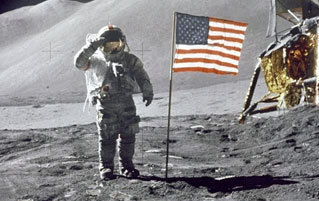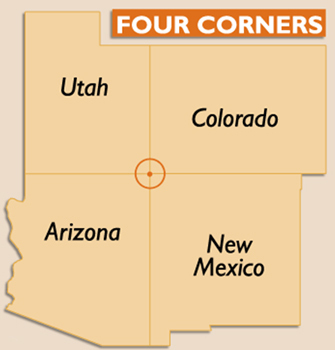5 Myths You Probably Believe About Famous Landmarks

The whole point of landmarks is that they let you know at least one thing about a place you've never been. Maybe you've never set foot in New York, but you know you'll find the Statue of Liberty there, welcoming immigrants. Go to Stonehenge and you'll find a bunch of rocks the ancient druids put there for some reason. But, as with anything else we think we know, the most basic facts about famous landmarks turn out to be mostly wrong.
No, There Isn't an American Flag Standing on the Moon

The Myth:
On the gray, desolate surface of the moon, you'll find a vivid symbol of freedom: the American flag, planted into the lunar surface by Neil Armstrong. Its stars and stripes offer both a promise of freedom and the message that if anyone drives recklessly past the flag on their way to Earth, they can soon look forward to being punched in the face by Will Smith.

"Your emissary's haymakers were as flawless as his enunciation."
In fact, given the number of Apollo missions, there should be half a dozen or so flags on the moon now, making its surface more visibly American than a NASCAR race on Independence Day.
But Actually ...
According to Buzz Aldrin, he and Neil Armstrong accidentally placed the original American flag too close to their spacecraft, and when they took off, the flag was blown away. Whoops.

The film crew was already on overtime, so the director decided to wrap instead of shooting the scene again.
It's true that subsequent flags planted by astronauts are still standing, but the message we're sending out to any passing aliens is less "America, fuck yeah!" than "WE SURRENDER."
Which is to say, they're not American flags anymore, just hunks of white cloth. You know how dye tends to fade in the sunlight, like when depressing old video stores used to leave their movie posters in the window too long? Well, when you leave fabric outside on a barren space-rock without the protection provided by the atmosphere, it fades even quicker. All the American flags lost their colors a long time ago, and are now a surrender-friendly shade of white.

"Look! The Earthlings are displaying the white flag of war! Man your battle stations!"
Maybe that's not such a bad thing: If alien invaders do stop there first, perhaps it will make them let their guard down.
No, Stonehenge Wasn't Built by Druids

The Myth:
Stonehenge, the mysterious giant monument in England that looks like a drunken domino game played by God, is a work of the druids -- the priestly caste of an ancient Celtic tribe -- for use in their mysterious ceremonies. This Stonehenge/druid connection pops up everywhere, from the Spinal Tap movie to real-life seasonal druidic ceremonies at Stonehenge, which have been going on since the early 20th century and offer a slightly more socially acceptable way to dress up in white robes and call yourself a wizard.

They're also not afraid to cut any Harry Potter fans who encroach on their turf.
But Actually ...
The fact is, no one knows much about the people who built Stonehenge. The builders didn't leave any written documents or little self-portraits carved into the rocks or anything. We do know one thing, though: It wasn't the druids. Carbon dating puts the finished monument centuries before the Celtic tribe with druid priests even arrived in Britain, and since it took over 1,000 years to build, we're pretty sure that means they weren't around during the initial building consultations.
This isn't exactly surprising, though, because everything we know about druids has them worshiping in oak groves, not in open plains more suitable for picnicking.

Real druids weren't much into the whole "dancing naked under rocks" thing. They hadn't invented Ecstasy.
So how did the monument become so connected with druidism? We can thank 18th century archaeologist William Stukeley, who popularized the theory. Stukeley was a member of a historical re-enactment club in which he played a druid called Chyndonax, and in his spare time was fond of re-enacting druidic ceremonies with his wife (as weird as you think it is, trust us, it's weirder).
So, given that this druid-obsessed dude was basically the 18th century version of the Ancient Aliens Guy, it wasn't surprising that when it came to Stonehenge, his opinion was "Screw it, probably druids." He was the kind of guy who probably thought druids were behind everything.

"I'm telling you, it was the druids who left an upper-decker in your toilet, Steve."
Four Corners Monument Is Not, in Fact, at the Intersection of Four States

The Myth:
Four Corners Monument is a quadrilaterally neutral landmark to celebrate equality, cooperation, and the joining of different tribes and peoples into a single, proud entity: a modern American nation spanning both coasts and everything in between.

Nothing says "patriotism" like the arbitrary intersection of two imaginary lines.
There's no other place in the country where four states meet up at the same point, and this monument is unique because it stands at the exact intersection of Arizona, New Mexico, Utah, and Colorado, allowing countless tourists to take photos proving they have "stood in four states at once."
But Actually ...
If it's not exactly in the right spot, then it's pointless and just a stone blemish set against a serenely beautiful desert backdrop. Plus, "Come see the point where a bunch of states almost come together" is a much less effective slogan to draw crowds of tourists. However, recent surveys have shown that this is, sadly, the case. Originally, critics claimed the monument was 2.5 miles away from the actual spot where the states join, so the government did a survey to prove them wrong and found that it's "only" about 1,800 feet away from where it's supposed to be.

"Bet you critics feel dumb now!"
Incidentally, the government has declared that, regardless of its location, Four Corners Monument is legally in the correct spot. Except that in reality it isn't. And even though geology has had a 4.5 billion-year head start on bureaucracy, the latter wins because lawyers.
We don't feel like this is being pedantic here -- we can understand if maybe some battlefield monument isn't exactly where Custer was killed or whatever. Hell, we don't even mind if a famous tomb doesn't contain the figure supposedly housed there -- the idea is to give people a place to pay their respects. But the Four Corners Monument only exists because of its physical location. That's the entire point.

Welcome to ... just some random part of Utah.
What We're Calling London Bridge ... Isn't

The Myth:
When we think of England, we can't help but picture gray skies, Big Ben, guards in funny hats, the letter "u" in places it shouldn't be, and London Bridge. Whatever stereotypical thing you believe about the Brits when it comes to food or orthodontics, they sure as hell know how to build towers and bridges.

That hasn't stopped children's nursery rhymes from spreading cruel, vicious rumors otherwise.
But Actually ...
It turns out that when people talk about the London Bridge, they're mostly talking out of their ass, because what they're actually thinking of is the Tower Bridge. We don't mean they're just getting the name wrong, either -- they are two completely different things. Even Google has it wrong -- a quick "London Bridge" search brings up this as the main picture:

"Did you mean 'the cool bridge that everyone actually cares about'?"
That is not London Bridge. That is Tower Bridge. It was never London Bridge -- it's like searching for "Empire State Building" and getting a picture of the Chrysler Building. Our friends at Wikipedia actually have it right this time. A search over there brings up the actual London Bridge, which opened in 1973:

Seen here in the timeless color of hot pink.
No one entirely knows why the bridges have been confused with each other; it's just one of those cultural things that has happened, and continues to happen. You hear the "London Bridge is falling down" song and you picture the big pointy bridge in London. Occam's razor dictates that you must be correct. Of course, you're not.
Everything About the Statue of Liberty

The Myth:
Ever since the French built it, the Statue of Liberty has been a unique symbol of American freedom and hope. More specifically, it has always been a special symbol of American immigration, welcoming newcomers to Ellis Island, as demonstrated by the poem attached to its pedestal:

"When do we get the free handguns?"
But Actually ...
Originally, the statue had nothing to do with immigrants at all; tired, poor, or otherwise. Immigrants weren't mentioned during the statue's dedication ceremony in 1886, and the "give me your huddled masses" poem by Emma Lazarus wasn't attached to its pedestal until almost 20 years later, at the urging of a friend of hers, who had found the forgotten poem in a used book store. But the real connection of the statue with immigration only took off during World War I, largely as part of a campaign to sell war bonds. This came about when an enterprising youth sketched out a totally rational and not-at-all-ginned-up image of New York City being strafed while an extra crispy Statue of Liberty looked on mutely.

Thus beginning the longstanding tradition of depicting the statue's demise in absurdly elaborate and exotic ways.
In fact, in the early years the statue was more commonly used as an exclusionary symbol by white supremacists, who saw it as an "us vs. them" motif. As in a "this land is our land, there's the door" type of attitude.

Exemplified when she was used to deport Vigo the Carpathian.
And while the statue was given to the Americans by the French, it wasn't given so much as a reward for being awesome as it was as a demonstration of French engineering skill coupled with a political statement against the French government. When the statue's planners first came up with the idea, France was ruled by authoritarian and general dickbag Napoleon III, and the designers wanted to express their displeasure in a passive-aggressive "Hey, isn't American freedom dreamy?" kind of way. In fact, the French national government wasn't involved in the statue at all -- much like a 19th century Kickstarter project, the statue was financed largely by donations from normal French men, women, and even children.
And then, strangest of all, there's the controversy that came up from Roman Catholics, who considered the statue a graven image. They had serious concerns with New Yorkers' deference to a massive "heathen goddess" with some pagan roots, and they actually had a point -- the statue was basically a depiction of the Roman goddess Libertas, with a side of Asherah, a pagan god, thrown in for good measure. And while no one was actually worshiping said statue, there was no denying that erecting a 150-foot-tall goddess woman in New York Harbor would cause a stir. Seriously, go try it.

"Hey, at least it's not straddling the inlet so that every ship that passes under it has to look at its taint!"
C. Coville's Twitter is here.
We have some bad news: ancient Greece was covered in tacky pastels, the ancient Egyptians didn't 'worship' their Pharaohs and your favorite book sellers are now taking pre-orders for a text book written and illustrated entirely by the Cracked team! Hitting shelves in October, Cracked's De-Textbook is a fully-illustrated, systematic deconstruction of all of the bullshit you learned in school.

It's loaded with facts about history, your body, and the world around you that your teachers didn't want you to know. And as a bonus? We've also included the kinkiest sex acts ever described in the Bible.